Air quality indoors is often much worse than outdoors, regardless of proximity to industrial sites, highways, or other hazards. Here are our top picks for indoor air quality monitors to ensure you are breathing clean air at home.
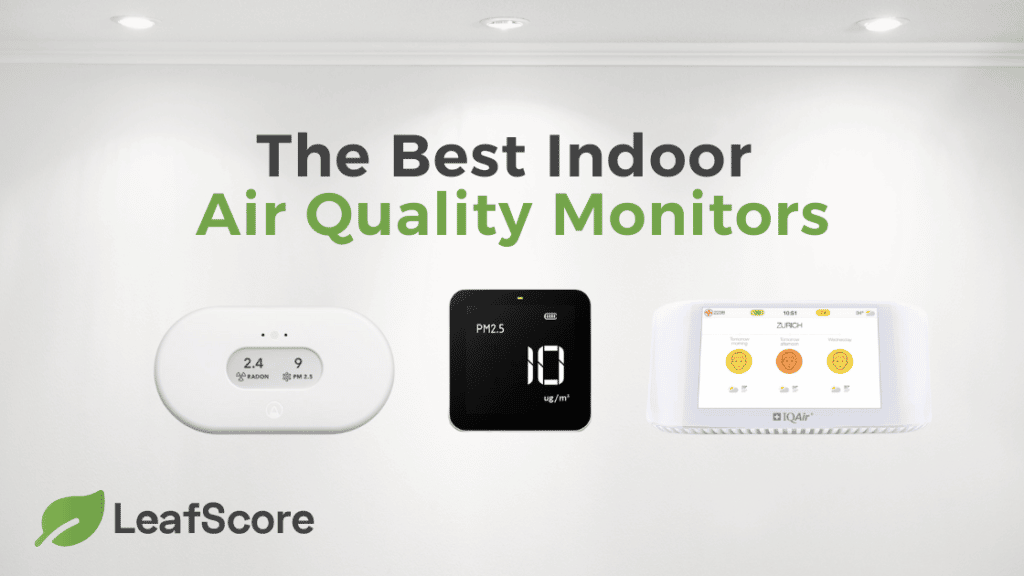
Table of Contents
I live near a pulp and paper mill in an area prone to forest fires, and I have a young baby. So, like the nerd I am, I have the nearby air quality monitoring station bookmarked in my browser. If you’re concerned about the quality of the air inside your home, as we are at LeafScore, there’s a simple way to test it.
Below, you’ll find my picks for indoor air quality monitors, with tips for improving indoor air quality at home.
How to choose the best air quality monitor
A few notes before we jump in.
- Indoor air quality monitors typically test airborne particles and some volatile organic compounds in a localized area. Most monitors don’t test for carbon monoxide or radon, though. If you have old gas appliances or other reasons for concern over carbon monoxide, install a monitor ASAP. This gas can be deadly. As for radon, check the EPA’s guide to radon to determine the risk in your area (and what to do about it).
- Choose a monitor that has a good reputation for detecting the kinds of indoor air pollutants you suspect are an issue in your home. Some monitors can accurately measure smaller particulate matter that can enter the lungs (around PM2.5), or PM1, which is strongly associated with cardiovascular disease risk. Most monitors aren’t this sensitive, so if it matters to you, check the specifications carefully.
- The EPA has studied indoor air quality monitors extensively and is quite scathing about their accuracy, especially over time. A 2019 report strongly suggests that these low-cost sensors tend to become less effective at detecting VOCs after six months. Unlike with other products, we don’t, therefore, recommend borrowing an older monitor. In fact…
- Because indoor air quality monitors are limited in their usefulness, you don’t necessarily need to buy one at all! Instead, check outdoor air pollution levels through the EPA app and keep doors and windows closed on particularly bad days.
- Finally, even if your monitor tells you everything is normal but you still suspect something amiss with the air in your home, follow your hunch and take the above steps to improve things.
Now, to the monitors!
The best indoor air quality monitors: our top picks
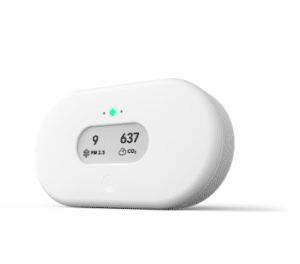
Airthings View Plus
Highlights: Newer model from a well-regarded air quality monitor company – gives readings for radon, PM2.5, carbon dioxide, and more. WiFi connected and has a simple display that quickly shows a variety of customizable readouts right on the monitor.
LeafScore readers can take an additional 10% off their Airthings purchase using coupon code LEAFSCORE-10OFF.
The Airthings View Plus is a newer model offering greater functionality than its predecessors. Its seven sensors test for radon, PM2.5, CO2, humidity, temperature, air pressure, and VOCs. You can mount the very discreet monitor on a wall or on a table.
This monitor is WiFi enabled and collects data on nearby outdoor air quality. You can plug it into a USB-C port to use it as a hub to bring additional monitors online. Use Bluetooth to set it up and to configure the monitor for daily use.
The View Plus offers a more informative on-device display than the Wave Plus. This display is very calm and pleasing and you can customize it to show the data most important to you. With the Wave Plus, you have to log into your smartphone app. to see the measurements.
The simple interface makes it easy to quickly toggle through all the data/readings. A small light in the center glows green, yellow, or red to indicate good, moderate, or bad air quality.
The View Plus offers short- and long-term graphs of data, with more detail via the app. It also offers tips on improving indoor air quality. The measures include passive diffusion chamber radon sampling, alpha spectrometry, non-dispersive infra-red (NDIR) for CO2, and laser scattering based optical particle counter for PM2.5.
The View Plus has IFTTT functionality and connects to Amazon Alexa and Google Assistant. You can run the ViewPlus for up to 2 years using 6 AA batteries (depending on various factors). Or you can plug the monitor into a USB-C port. The monitor measures 17 by 9 by 3.3 cm (bigger than other monitors listed here).
The company offers free shipping, 1-year warranty, and a 45-day money back guarantee. There’s an initial calibration time of 7 days for VOCs and CO2. This monitor is intended for use between 4-40°C / 39.2-104°F and humidity of 0-85% (non-condensing). Read our full AirThings View Plus review.
We staff tested the Airthings View Plus
LeafScore team member, Dan Simms, tested the Airthings View Plus at his home in Long Island. Learn more about Dan’s experience in the YouTube video below.
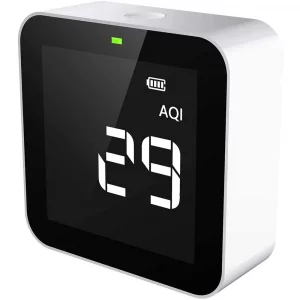
Temtop M10 Air Quality Monitor
Highlights: Simple, affordable, seemingly accurate monitor without the fuss of WiFi, apps, and smart tech hookups.
The Temtop M10 Air Quality Monitor is a good bet for monitoring indoor particulate matter and is simple to use, with a bright display that’s easy to understand. This monitor also feels robust, doesn’t take up much space, and is very affordable.
The M10 measures PM2.5, VOC, and formaldehyde (HCHO) and gives an air quality index (AQI) based on these. Its readings appear to be accurate on third-party testing, with the exception of VOCs, which seem variable.
You can easily read the monitor, even from across a room. To operate the device, you push a single button to turn it on and cycle through readings.
The M10 isn’t WiFi enabled. This means you don’t have to worry about paying for tech you won’t use or that will be glitchy. However, it also means you can’t see readings on a smartphone app. or easily track air quality over time. This monitor doesn’t offer outdoor air quality data and doesn’t hook into any smart air filters or home ventilation systems.
The reviews of this air quality monitor are, admittedly, mixed. Some users love it and some have found it faulty right out of the box. Temtop offers a 45-day return period and a limited one-year warranty, however.
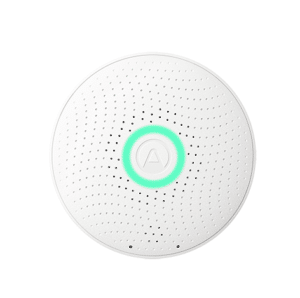
Airthings Wave Plus
Highlights: Great-looking battery-powered air quality monitor that detects radon and hooks up with smart home devices.
The Airthings Wave Plus is a slightly simpler version of the ViewPlus but still offers 6 sensors for radon detection and monitoring of CO2, TVOCs, temperature, humidity, and air pressure. This discreet, simple home air quality monitor won 2019 TIME Magazine invention of the year. It offers touch-free color-coded indicators for overall air quality but doesn’t have the same convenient display as the ViewPlus.
Instead, this battery operated, indoor air quality monitor offers comprehensive data via the free Airthings Wave app. on your smartphone. The monitor also connects to IFTTT smart home devices, Alexa, and Google Assistant. You can leverage the live data to set alerts, receive air quality measurements, give voice commands, and connect to a smart plug or smart product to control your thermostat, air purifier, or humidifier.
The Wave Plus measures 12 cm by 3.5 cm and weighs around 220 grams. It can hold charge for up to 16 months and you can wall mount it if desired. There’s a 7-day calibration period for radon measurement (and likely VOCs too).
We’ve worked with Airthings to get LeafScore readers an additional 10% off their purchases using coupon code LEAFSCORE-10OFF – make sure to use that if you end up buying!
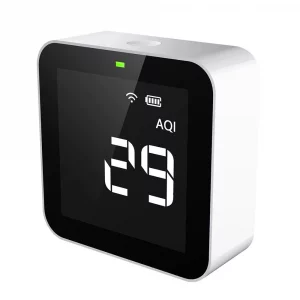
Temtop M10i WiFi Air Quality Monitor
Highlights: The same benefits of the M10 but with WiFi connectivity and a smartphone app. to track readings over time and turn the monitor on and off remotely.
The Temtop M10i WiFi Air Quality Monitor is a copycat of the M10 but with WiFi connectivity. This device requires a 2.4 GHz network and offers a straightforward app. for iOS and Android. It’s simple to connect to WiFi, after which you can use the app. to turn the monitor on and off, see current readings, and track data over time. It also displays the local weather forecast.
The Temtop M10i has a 3rd generation laser particle sensor with a maximum lifespan of 20,000 hours. This amounts to about two-and-a-quarter years (Temtop says 3 years for the PM2.5 sensor, which seems overly optimistic). The sensor plus ‘unique particle swarm optimization algorithm’ makes for a more accurate and stable particle measurement, according to Temtop.
The M10i costs up to $80 more than its basic counterpart, depending on where you buy it. Frankly, the additional features don’t seem worth the cost. (I’d go for the Airthings model instead.)
The M10i weighs just 200 g and measures about 8 by 8 by 3 cm. It has a 2200mAh battery offering up to 6 hours of battery life. The measuring range for PM2.5 is 0-999 ug/m³. For total VOCs, the measuring range is 0~5mg/m³. For formaldehyde, the measuring range is 0~2mg/m³.
The Temtop M10i offers an AQI based on ozone, fine particulate matter, nitrogen dioxide, carbon monoxide, sulfur dioxide and total reduced sulfur compounds.
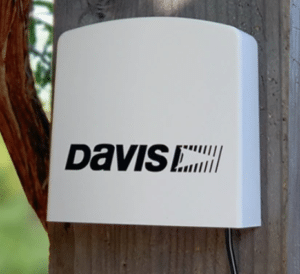
Davis Instruments AirLink
Highlights: A great choice for smaller particulate matter and to hook into robust weather and air quality stations across the US. Doesn’t measure VOCs or CO2 and lacks a visual display (use your smartphone to access data).
The AirLink is a great choice for an air quality monitor if your biggest concern is particulate matter down to 1 micron. Unlike most other monitors (the Dylos DC1100 excepted), the AirLink can measure this much smaller size of particle and can be used indoors and outdoors.
The makers of the AirLink, Davis Instruments, has a good reputation for its weather stations, and the AirLink itself appears to be precise and accurate. Your AirLink can also connect to Davis’ WeatherLink software, meaning it can display data from the company’s weather stations. The monitor can even send you real-time text and email alerts if your air quality changes dramatically. This makes it a good choice for areas prone to smog, dust, pollen, and wildfires.
This isn’t the most attractive air quality monitor, however, as it has a rather industrial design. It has white ABS plastic housing and shows the Davis logo on the top. You can wall-mount the monitor using a bracket on the back, or just set it on a table. The company includes a second cover to protect the monitor for outdoor deployment. It can operate at temperatures of 14-140°F, but you will need access to an AC outlet.
The major downsides to this monitor include no measures for VOCs or carbon dioxide. It also lacks a visual indicator/simple display. Instead, you have to read measurements on your smartphone or computer.
Thankfully, it’s easy to register an account with AirLink and use Bluetooth to set up the monitor initially. The associated (free) app displays several measures of air quality for quick check-ins. These include the current AQI score and previous hour’s score; current weather; PM10, PM2.5, and PM1 readings; indoor temperature and humidity; and sunrise and sunset times.
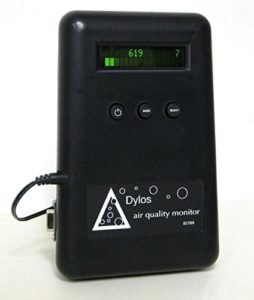
Dylos DC1100
Highlights: Great for folks wanting raw data, but offers no simple AQI and is very hard to use for the average user.
The Dylos DC1100 is an air quality nerd’s dream. It offers reams of raw data, up to 30 days of data history, and can detect particles measuring 1 micron. The trouble is, you have to interpret all the data yourself, with no simple color coding or easy-to-read overall AQI.
The Dylos DC1100 uses a true laser particle counter and can count particles big and small (5 microns and above, and 1-5 microns). The DC1100 Pro has all the features of the standard DC1100 but can detect particles down to 0.5 micron.
You can choose between the DC1100’s continuous mode and a monitor mode, where the device continuously sample the air or samples it for a minute every hour, respectively.
You have to plug in this monitor though, and at 3 by 4.5 by 7 inches it’s quite chunky. It also has a serial port interface, so you have to plug it into a computer to access the data. The bonus, though, is that you can use a 9pin serial cable or USB-to-COM Port Adapter (not included) to connect the DC1100 to your PC or laptop. This captures the data to output a CSV file showing particle counts at different sizes for every minute of monitoring.
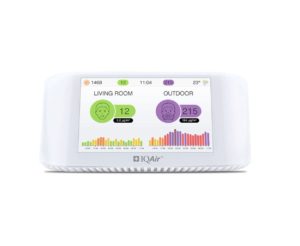
IQAir AirVisual Pro
Highlights: Easy to connect to WiFi, with a simple app, but a clunky device interface and at a high price for so little data.
IQAir is one of my top picks for an air filter, but the company’s air quality monitor is just… okay. This monitor is very expensive and doesn’t offer much more than PM2.5 and carbon dioxide measures. For the price, it should have much more functionality and be easier to use.
This monitor connects easily to WiFi and has a straightforward app that offers suggestions on improving indoor air quality. The device itself, though, is rather unintuitive, making it unnecessarily difficult to figure out the interface.
The IQAir also offers data on temperature and humidity and can offer historic data tracking. This monitor also has If This, Then That (IFTTT) functionality, so you can set up alerts for high readings. The IFTTT tech also hooks into other smart tech in your home, such as any smart IQAir filters.
This monitor also has an internal battery and data storage, so you can take it while traveling. You can access your historic air quality data through the smartphone app. or via the company’s website.
Air quality FAQ
It’s important to keep an eye (nose?) on outdoor and indoor air quality. To monitor outdoor air quality in the US, use the Environmental Protection Agency’s AirNow mobile app. This is free on iOS and Android, and you can search by zip code or place name to find a nearby air quality station in the US. These stations offer real-time data but don’t account for the conditions inside your home, nor any wind, valleys, or other factors that can alter air quality significantly.
Gas stoves, especially when used in kitchens with poor ventilation, can have a deleterious impact on indoor air quality. For more, see our post discussing the pros and cons of cooking with gas.
Once you’ve tested the air inside your home, you might decide you need an effective air purifier. This could be a central air system or just a single air purifier in one room, such as a nursery, kitchen, or poorly ventilated workshop or basement. A good quality air purifier can help filter some of the worst offending air pollutants, but the best approach is to limit the pollution in the first place.
To improve indoor air quality, consider eliminating or reducing the following sources of indoor air pollution:
Nasty old non-stick pans
Decrepit heating appliances
A gas stove
Candles
Tobacco smoke
Poorly stored paints, solvents, glues, and other chemicals
Old polyfoam mattresses or couches that are kicking up toxic dust
Harsh cleaning products
Perfumes and scented personal hygiene products
Scented room sprays
Carpets or rugs treated with toxic chemicals
Moldy or mildewy textiles, carpets, and furniture.
Removing or reducing as many of these potential indoor air pollutants is by far the best way to improve indoor air quality. You can see the impact of your efforts by using an air quality monitor as you make changes.
When you’re limited in ability to reduce pollution, running an air filter is often the next best option. Other ways to improve indoor air include regular vacuuming, installing an HVAC system, and even reducing clutter. That way, dirt and dander have fewer places to hide!
An air quality monitor can also alert you to issues with your air purifier or HVAC system, indicating a need to change the filters in these or your gas furnace. Air quality monitors can also indicate a need to clean the air ducts in your home. These can all make a big difference to indoor air quality. You can also just set yourself calendar reminders or get a subscription service to deliver new filters every month.
If air quality in your home seems worse than outside, open windows and doors on nice days. This will help any volatile organic compounds, cooking odors, and other air pollutants disperse.
Finally, in addition to taking steps to improve your indoor air quality, you can improve overall air quality with a few smart lifestyle choices. These include choosing a green energy provider, minimizing flying and driving, using an EV, installing a smart thermostat, and putting pressure on companies to adopt greener manufacturing practices, among other things.
Great list. I love that you can now measure VOCs and formaldehyde now. But something that needs to be created and more consumers should be concerned about is mycotoxins. Air quality has become not only super important to me but vital for my recovery. This tends to be a blind spot for so many. It’s sad as it’s a rather common problem, many incompetent on topic, many suffering from it, diagnosis is hard as it looks like everything else, and can make someone very sick. Personally speaking, I went green before it became popular and it was because I just felt a tad off. All the green living in the world didn’t overcome the toxic mold hiding in our home. At first, my symptoms were mild. I just felt a little tired. Slowly but surely, I got sicker and sicker. 12 years later, I was bedridden. I see the article mentions moldy carpet but there’s soooo much to cover. Moldy carpet is a problem but active growing toxic mold in a HVAC, in a concealed wall, crawl space basement, attic, etc would be much higher concerns. Not only does it damage the integrity of the structure but it’s literally toxic to humans, animals and plants. But somehow, people are completely unaware or think “mold is everywhere.” Toxic mold is not everywhere and should be be acceptable to anyone. But sadly, it’s more common than one would think.